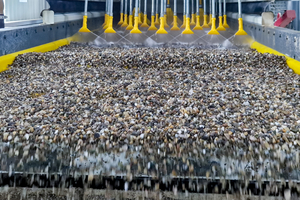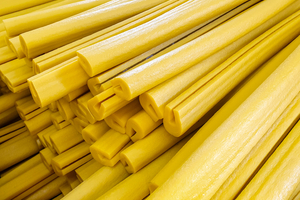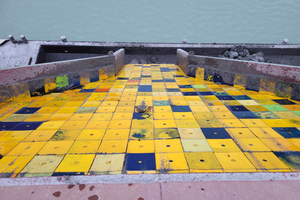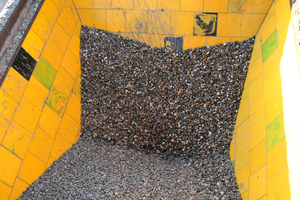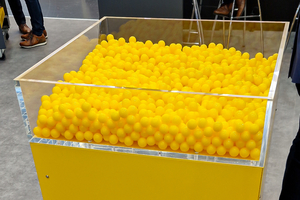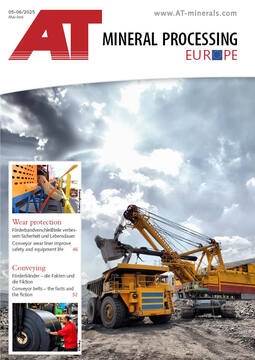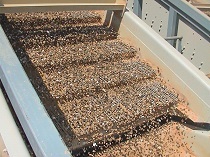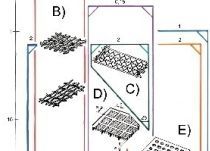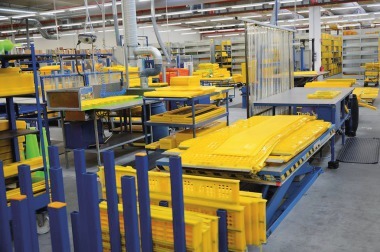Isenmann sets the course for a sustainable future
Raw materials are the basis of our progress – but they are finite. Isenmann has made sustainable extraction its mission and wants to make maximum use of natural raw materials in this way. In order to reconcile the requirements of users from the aggregates industry and mining for economic efficiency with the protection of nature, Isenmann focused on five topics at bauma 2025 that relate both to customer requirements and to each other.
The recycling question: Is an unusable screen liner useless?
For many years, Isenmann has been relying on the use of recycled polyurethane – and is looking for and producing new wear products that offer excellent alternatives to commercially available products from an economic and technical point of view. “Our new support bar protection profile number 9 is made of high-quality PU recyclate and is, for example, one of these products, which has proven its added value compared to commercially used rubber profiles with our customers in recent years. In the last year alone, we have been able to record a steep increase in demand,” reports Isenmann Managing Director Matthias Sattler. The material comes from production residues. The recyclable materials are freed from steel and other foreign materials and the polyurethane is prepared for further processing. “Sustainability starts first and foremost in our own production. This recycling cycle results in less waste and less virgin plastic has to be produced,” adds Isenmann Managing Director Jürgen Schwarz. “And we are actively thinking about the topic of recycling much further.”
For more than 15years, polyurethane, which is unavoidably left over after the casting process, has been collected directly in the moulds provided for this purpose. From this so-called drip the Isenmann product “Linetech” is created – a standardised wear protection solution with different fastening systems (screwed or with the patented WS 2.10 magnetic mount) for lining chutes, hoppers, baffle surfaces, stone ladders, chutes and more. Isenmann was once again a pioneer in the industry, implementing and successfully establishing the use of PU surplus materials from the PU production process for a product line (Linetech).
The 3D printing question: Will used screen linings
also be recyclable in the future?
The foundation has been laid. Now Isenmann is testing the limits of what is possible: If Profile 9 can be produced, can the recyclate also be printed?
With what resources and in what quality? “It is important for us to learn under which conditions additive manufacturing with recycled material offers an advantage for our customers. We specifically sought this conversation at bauma,” says Jürgen Schwarz. “Our success in this area is impressive and shows us the way to additive manufacturing of parts for the preparation of bulk materials and the production of high-quality wear protection solutions.”
In addition to the 3D printing of recycled polyurethane, the pressing of such polyurethane is also a topic that is currently being developed by Isenmann. “The basic feasibility is guaranteed,” Matthias Sattler is confident: “As soon as we have found the right partner with the right product, these Isenmann solutions will be found on the market.”
The material competence question: Which formulation for which application?
“The recycled material we produce exceeds all practical requirements and proves its capabilities every day in many applications of wear protection. It meets our high quality standards of the materials used. Our formulations of the original materials are always a well-guarded trade secret,” Jürgen Schwarz explains, “because yellow is not just yellow, stone is not just stone and polyurethane is not just polyurethane.” Yellow knocking balls on the Isenmann stand clearly showed the “jumping” difference.
Depending on the area of application, different formulations are required. In a series of tests, the Isenmann developers create new material compositions, continuously optimize existing ones and put them through their paces. How much does the material shrink, how well can it be removed from the mold, how well can the material be processed, what are the mechanical properties, how much tension can it withstand, how much abrasion resistance does it offer? In short: Where can more be extracted?
The design question: How do you increase efficiency in the long term?
“We know what to do to ensure that our screen panels generate the lowest wear costs for our customers when processing bulk materials,” explains Matthias Sattler. Isenmann’s sales and service employees are already on site for their customers as process consultants and analyze all influencing factors. “Our customers can achieve a lot with our recommendation and support throughout the entire classification and preparation process, with the regular maintenance of the screen linings and the material formulation that is precisely tailored to the application, as well as the ideal aperture geometry of the screen media.”
“We have the process expertise for the technical design in all its facets,” the managing director continues. “With this knowledge, we reduce our customers’ screen media consumption to a minimum, which is not only a benefit for the user, but also for the environment.”
The classification-as-a-service question: How do you screen more economically?
“We know that it is almost impossible for plant operators to maintain this perfect condition of their plants in the long term. The shortage of skilled workers and the cost pressure from all areas among our customers contribute significantly to this,” explains Jürgen Schwarz. “That’s why we want to offer our customers in Germany a unique service, just as we have already successfully established it in England: classification-as-a-service,” adds Matthias Sattler.
With this special service, Isenmann takes responsibility for the wear and tear in the customer’s screening process and the associated effects on the product quality of the screened material regarding overgrain. Similar to car leasing, the user does not buy the product, but the all-round service according to its use – in this case, the unit is the sieved material tonnage.
“In this new model, all our competencies come together: our expertise in materials and design, our innovative spirit – and ultimately also our expertise in the use of recycled materials,” says Jürgen Schwarz. Matthias Sattler adds: “The responsibility for maximum efficiency of the classification level lies with us. The customer can therefore rest assured that products recycled by Isenmann also deliver 100 % of this performance. And this closes the circle around the economic efficiency of our customers and sustainability in an ideal way.”

